Lately, I’ve started collecting old VHS tapes about the Internet from the early- to mid-1990s. While most of these are pretty corny — think Gabe and Max’s Internet Thing — they also inadvertently captured pieces of the web that don’t exist anywhere else. The Internet Archive’s earliest snapshots were in late 1996, so anything before that is extremely sparse. The videos, silly as they are, still represent valuable documentation of the early web.
I spent most of the day yesterday working on a workflow to digitize VHS tapes, settling on VCR to MiniDV camera my Macbook Pro with Firewire. These tapes are pretty worn, so the quality’s not great, but that almost adds to their charm.
Here’s the result: the first volume of a two-tape collection called “Internet Power!” from 1995. I’ve included some select quotes and screenshots below.
Internet Power – Discover the World of Online Entertainment (00:36)
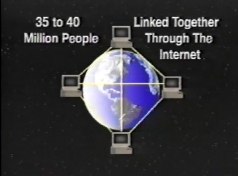
“The explosive growth in the number of people who have discovered the power of the Internet for learning, marketing and just plain having fun has been incredible. The Internet is changing the way we learn, work, and play forever. Today, some 35 to 40 million people from around the world are linked together through the Internet, the world’s largest computer network. Students of all ages are discovering the online power of the Internet as the ultimate tool for learning. Whether you’re in grade school or college or beyond, or you just want to be entertained and have a good time, the Internet has something for everyone.”
I love the Windows 3.1 references, and that they used 8-Ball Pool for Windows to demonstrate the power of the Internet.
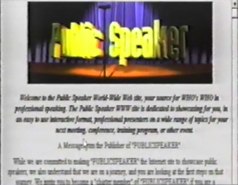 “But before we go too far, let’s take a moment and have a look at just what the Internet is and what it takes to start surfing through Cyberspace. You may already be a net surfer and you may want to skip this section, but if you’re just starting out, we suggest you spend a few minutes getting familiar with some of the most common Internet terms.”
“But before we go too far, let’s take a moment and have a look at just what the Internet is and what it takes to start surfing through Cyberspace. You may already be a net surfer and you may want to skip this section, but if you’re just starting out, we suggest you spend a few minutes getting familiar with some of the most common Internet terms.”
Dig that mid-1990s design aesthetic. Grey background, huge 3D rendered header graphic, Times New Roman italic, centered text… It’s 1995, all right.
“You’ll need a device to access the online world. That device is a Computer, with at least 386 power and 8 megabytes of RAM and has a modem installed that has 14.4 or greater speed or ‘baud rate.’ And of course, access to a phone line. If you have a slower modem, you will not be able to enjoy the growing multimedia aspects of the Internet, such as graphics, sound, and video.”
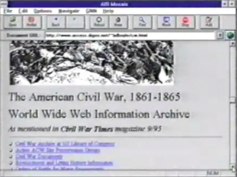 “You will also need a connection to the Internet that connects your computer to the millions of other computers that make up this Superhighway of Information.”
“You will also need a connection to the Internet that connects your computer to the millions of other computers that make up this Superhighway of Information.”
A number of vintage ISPs and screenshots are included, followed by an interview with a Microsoft tech named Bret Arsenault. Bret’s the only person interviewed in the video, as the resident expert.
“Any of the online services, such as America Online, will provide you with a connection to the Internet, along with a navigation tool called a Browser which enables you to move from location to location anywhere in the world.”
The browser pictured is AIR Mosaic, provided with Spry’s Internet in a Box.
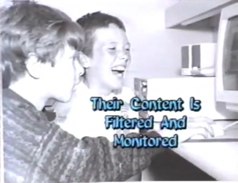 “Parents concerned about unwanted content may want to sign up with a major online service where you can be assured that their own content is filtered, and then have your child advise you when they’re going directly onto the World Wide Web and provide parental supervision as required. There are software packages in development that will assist parents in locking out unwanted Internet content in the future.”
“Parents concerned about unwanted content may want to sign up with a major online service where you can be assured that their own content is filtered, and then have your child advise you when they’re going directly onto the World Wide Web and provide parental supervision as required. There are software packages in development that will assist parents in locking out unwanted Internet content in the future.”
“The Internet has been around since the 1960s, but it was the development of the Mosaic browser in 1933 at the University of Illinois that made it possible to simply point and click your way to information that not only contained text, but also graphics. Now the average person can enjoy the full potential of the Internet, and especially, the fastest-growing part of the Internet called the World Wide Web.”
Yes, he said 1933. Apparently, the launch of Mosaic ushered in the Great Depression. Some nice shots of the original Smithsonian site, and a basic explanation of the Web by Arsenault and the narrator. How did you describe the Web in 1995?
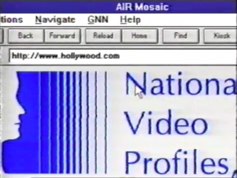 “A Web site is like a book that is divided into chapters. By clicking on the hypertext links, you choose which pages you want to view in the book. A Home Page is like the first page of the book, with a Table of Contents and general introduction into what is contained in the site.”
“A Web site is like a book that is divided into chapters. By clicking on the hypertext links, you choose which pages you want to view in the book. A Home Page is like the first page of the book, with a Table of Contents and general introduction into what is contained in the site.”
Next comes a brief introduction to domain names, FTP, Usenet, Gopher, and email, before launching into the next section: Search Engines.
“When it comes to fun and entertainment, the power of the Internet is unlimited!”
Search Engines (08:04)
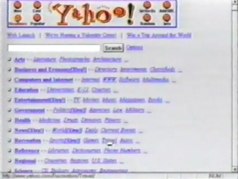 “To get started, we have to sift through the vast amounts of information on the Internet and find what we need. The best way to do this is by using one of the many Search Engines available. These sites gather the information that is out there and categorize it so we can narrow our search. One popular site to do this is called Yahoo!”
“To get started, we have to sift through the vast amounts of information on the Internet and find what we need. The best way to do this is by using one of the many Search Engines available. These sites gather the information that is out there and categorize it so we can narrow our search. One popular site to do this is called Yahoo!”
The list of search engines on the slide is a great flashback. “Web Crawler, Lycos, Einet, WWW Worm, Yahoo, Info Seek, Savvy Search… and More”
“Normally, these sites would take a few seconds to load to your computer, but in the interest of time, we’re cutting to them through editing for the purposes of this video.”
Later, they cover a long-lost site called “The Weatherman,” where you email your trip profile and a nice guy named George Gatto emails you a weather forecast by hand. I can’t imagine that’d scale very well.
Gopher (12:04)
“Gophers can be a one-stop source for finding information on the Internet. This particular site has many categories to choose from. Let’s keep our same subject, weather, to see how this differs from our Yahoo! search.”
Shopping (13:20)
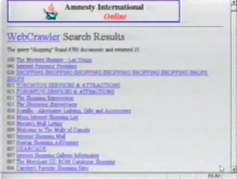 “The Internet has thousands of sites for shopping and many of them are grouped together in large Internet Malls… Let’s try a different search engine this time. We’ll use another popular one called Webcrawler.”
“The Internet has thousands of sites for shopping and many of them are grouped together in large Internet Malls… Let’s try a different search engine this time. We’ll use another popular one called Webcrawler.”
“Let’s choose one… The Mega Internet Shopping List sounds promising!”
I could go on all night. Later, they cover Online Games (16:36) and Online Entertainment (20:42), but the Online Magazines section (25:35) is my favorite, with screengrabs of Hotwired, Nintendo Power, and the craziest sitemap ever from a very early Time.com.
“You’ve got a lot of exploring to do, so surf wisely and have a great time!”
URL Addresses for Websites We Visited (27:35)
The Smithsonian, http://www.si.edu/
The Discovery Channel Online, http://www.discovery.com
The Weatherman, http://pixi.com/~gattoga/index.html
The Rock & Roll Hall of Fame Online, http://rockhall.com
Hollywood Online, http://www.hollywood.com
America Online, http://www.aol.com
Yahoo!, http://www.yahoo.com
The Internet Mall, http://www.mecklerweb.com:80/imall
The Toystore, http://www.toystore.com
Nintendo of America Online, http://www.nintendo.com
Happy Puppy Game Site, http://www.happypuppy.com
3D Riddler, http://cvs.anu.edu.au/andy/rid/riddle.html
CBS, http://www.cbs.com
NBC, http://www.nbc.com
PBS, http://www.pbs.com
ESPN, http://www.espnet.sportszone.com
Hotwired, http://www.hotwired.com
Time, http://www.timeinc.com
Price Costco Online, http://www.pricecostco.com
Credits (28:15)
Where are they now? Paul Barnett was Internet Power’s executive producer and it was produced, directed, and edited by Steve Ducharme — they later co-founded another company, the Internet broadcaster iShow. Bret Arsenault, originally an “Architectural Engineer, Internet Technology,” is now Microsoft’s Chief Security Advisor. (Here’s a recent webcast featuring Bret.)
Fun with VHS
Now that I’ve nailed the workflow, I’m going to be digitizing more of my collection. If you have any other classic Internet goodness locked up on VHS, get in touch. I’ll happily put it online for you.

Wow, I love that old school Nintendo site. Amazing how far things have changed in ten years.
Wow. Thanks for the play by play. Makes me want to dive into the Computer Chronicles archive http://www.archive.org/details/computerchronicles
Really fantastic video there Andy. Can’t wait for the second installment! Bit of a slip of the tongue at 04:35 though:
Very, very awesome. Great to remember where we came from. In some ways we’ve come very far, and yet “the Internet” is still pretty hard for a lot people to use.
You might want to consider using Viddler (http://www.viddler.com) for your videos. They allow timed tagging, so that instead of having to list the times in your description, people can navigate directly to them during playback.
I tried uploading it to Viddler, and prefer their seeking/annotating options to Blip, but their server was way too slow. It was constantly buffering video.
how about that 1985 episode of Benson where they use ARPAnet? I still remember Missy Gold explaining “modulator/demodulator”.
Andy, this is so great. Thanks for digitizing this and putting it up. Plus, I’ve always wanted to sound like one of those informercial guys, so now I know how to correctly say things like “text and graphics.” and “World Wide Web” and “home page” and “web site” with the appropriate intonation.
The Ultimate Tool For Learning!™
(this rocks)
Now this is what I call public service. Thanks for a great blog.
What’s VHS?
Oh the memories… Pipeline in NYC was my favorite ISP actually, I think I may still have a disk somewhere
I remember when http://www.happypuppy.com was the biggest gaming site on the Internet. I only had a 2800 baud modem at home, so I had to go to a university computer lab to download demos.
check out the Tim and Eric episode called “The Innernette” for an absurdist spin on this retro aesthetic
Oh man, I love using the way back machine to look at old websites I use to hit. It’s amazing what 10 years and a little more bandwidth can do for us.
“America’s favorite pastime” – pause, pause, pause “SHOPPING!” So sweet – I guess porn hadn’t been invented yet!
@lulu: Porn didn’t come out until 1933.
Wow, thanks for the memories. The amusing thing is none of the site owners were contacted about this. I used to run “the Internet Mall” (it was part of iworld, later to be renamed internet.com ) and we were actually surprised when we learned that people had seen us on TV 🙂
Some thing that I found that makes this wonderful video hard to view is the ground hum in the audio. A cheap fix for this is to use a ground loop isolator put between the VCR and the camera audio leads. You get one for about $15 on the Internet or your local RadioShack. Thanks for the video I look foreword to more.
Thanks for the tip! I just replaced the video with a new one with cleaned-up audio. Hope that’s better.
At about 4:50 into the first video, does he say Mosaic was created in 1933?
Somewhere in my bunch of old Pal format LP VHS tapes I’ve got a few BBC shows called “The Net”. There’s some early examples of WWW, Usenet, IRC, Gopher (whatever that is…) along with other features such as a couple guys trying to set up Internet access via Ham radio. I think the shows aired in 1994. Unfortunately the recording quality is very poor. I’ve no means of connecting my VHS deck directly to the PC but I can easily record to DVD then read them off as vob or mpg. Interested?
the internet is for pr0n
Mart: I’ll email you, thanks.
What a great treasure of old tapes! I stumbled upon an AOL welcome video from 1995, so great!
Check the video at 13:45. The third WebCrawler search result is: SHOPPING SHOPPING SHOPPING SHOPPING SHOPPING SHOPPING SHOPS SHOPS
I think they might sell things there.
Thanks so much for putting this up. Great piece of history indeed.
That’s destined to become a viral classic.
Did I hear them mention Usenet somewhere around the 25 minute mark? Wasn’t 1995 the year that AOL unleashed its newbie horde on Usenet, much to the NNTP community’s dismay. LOL!
I was hoping they’d have mentioned MUDs. In 1995, I wasted 90% of my free time MUDding.
It’s a real shame the BBC have yet to release Hyperland (http://en.wikipedia.org/wiki/Hyperland) – I believe there are some rights issues that make it very unlikely it will ever see the light of day – I’ve seen a bootleg and it’s fantastic!
Also let none of us forget Douglas Englebart’s mother of all demos:
http://sloan.stanford.edu/mousesite/1968Demo.html
awesome.
But what gives… why no digg buttons etc? this should be put out to the masses.
coming atcha thru the Squid, via RRW 😉
internet in a box!
I am extremely surprised that he didn’t warn of viruses, or am I being benign, were there no idiots abusing the technology back then?
I produced, edited and narrated that video many years ago. Thanks for digging it out. I haven’t seen it in years. We really have come a long way since then. I actually came out with a corrected version of that tape because of the “Mosaic developed in 1934” comment. In a later version it was changed to the correct year of 1936 (Kidding, of course, 1993.) We had to rent this gigantic VGA to NTSC converter for about $500 a day to capture those screens. It was huge, had to be rolled in and had an operator to work it. Must go now. Am feeing old. Thanks again.
Seeing the Android shareware pinball table gave me goosebumps. Great find.
Reading your comments. My first programming was on a mainframe in a locked room. Input was punched cards. I graduated to a Vic-20 and a cassette player for storage and then the IMB sytem 23 ( Mini ) lol. Then in 1982 I acquired for $8,200 my first IBM PC-XT 640 kb of ram and a 10 meg hard drive – never thought I could fill it. I still have a working 8088 chip PC in my collection ( my first build ) And I remember surfing the net with the fastest modem I could get – a 9600 baud. I was in heaven lol. Things have changed – most for the better. Thanks for the start of a walk down memory lane – obviously you are much younger than me.
Happy puppy games what a great name lol i remember when the internet looked like this.
Accident
At 4:40 it says Mosaic was developed in 1933. :/
Do you create this site oneself?